Stock Market Larger Uptrend Into 2011, Minor Top Set for Mid-November
Stock-Markets / Stock Markets 2010 Nov 01, 2010 - 08:39 AM GMTBy: Jim_Curry
 It's been a while since I have posted a market update, and - in light of the action in recent months - I want to post a detailed article on both the cyclic and the technical picture of the U.S. stock indices. I will start with the big picture view - which is decidedly bullish - and then will scale down to the short-term take, which is looking for a top between now and mid-November.
It's been a while since I have posted a market update, and - in light of the action in recent months - I want to post a detailed article on both the cyclic and the technical picture of the U.S. stock indices. I will start with the big picture view - which is decidedly bullish - and then will scale down to the short-term take, which is looking for a top between now and mid-November.
For the bigger picture, my basic call for the year 2010 (from the 2010 forecast issue) was for a rally into a late-April or early-May high, then to be followed by a decline with both the 180-day (9-month) and 360-day (18-month) cycles into the second half of the year. The bottom with these cycles was also favored to end up as the low for the 'presidential cycle' pattern, which has a history of recording major price lows in the stock market.
Since my last article, the SPX witnessed a late-April high of 1219.80 (which was projected by the 90-day cycle at the time), afterwards confirming the downward phases of both the 180 and 360-day cycles to be in progress. The SPX then declined into the Summer months, with the index recording a July low of 1010.91, and then made a secondary bottom in late-August at the 1039.70 figure. In September, based upon the technical action, the time cycles confirmed the July bottom as being a combination low for the 180 and 360-day waves - which means both are currently headed higher off the same.
With the above said and noted, here is a chart showing the larger four-year cycle, which was originally posted in a prior article back in March of this year. Here is how it looked at the time:
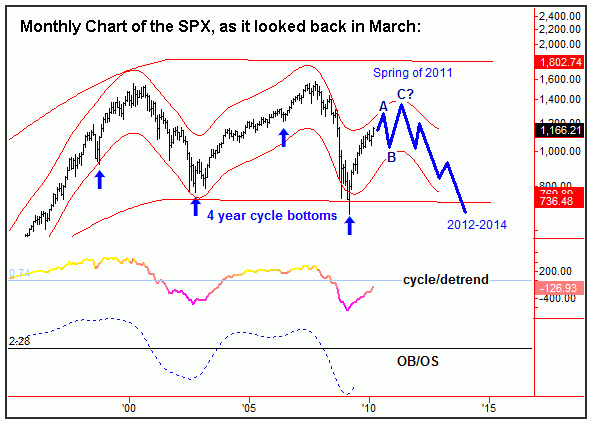
Note that the current upward phase of the four-year time cycle was favored to end up as a larger A-B-C retracement/rally, with the 'A' wave high coming as the result of the 180 and 360-day cycle tops - and the 'B' wave low being the bottom for these same two waves. That was then favored to be followed by a 180/360-day upward phase into Spring of 2011 or beyond, a move that will eventually peak the larger four-year component. Here is the updated version of that same chart below:
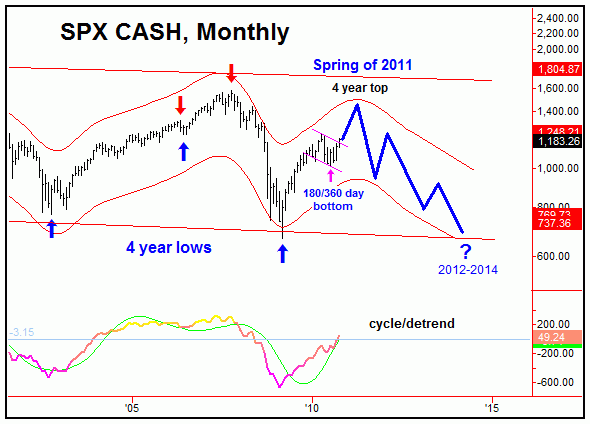
This is a monthly chart of the SPX CASH index. What we can note here is that the index is in the early stages of breaking out of a 'flag' pattern to the upside (shown in magenta) - a normal enough occurrence coming out of a 'B' wave bottom. As mentioned earlier, the current upward phase of the 360-day wave should take the SPX up to a final peak with the larger four-year component, ideally made at some point next year (more on this in a bit).
Back in September, the 180-day (9-month) cycle confirmed an upside target to the 1187.09 - 1226.23 range for the SPX - which was met on 10/21/10. Having said that, as this target was being approached, the same (180-day) cycle ended up confirming an additional upside target to the 1243.16 - 1286.36 area. With that, the current assumption for the mid-term picture is that we will see prices moving into this target range in the weeks/months ahead. This target could materialize before year-end 2010 - or, more ideally, could play out into January of next year.
In terms of time, there are some statistical observations that should be mentioned in regards to this 180-day time cycle. That is, when coming off the pattern of a 'lower-low' (which the 180-day cycle registered at the July bottom) the average upward phase of this cycle lasted 71 trading days or more before topping; however, a good percentage of these lasted 115 days before their peaks were in place. If something the latter were to play out on the current upward phase, then this cycle won't see it's next top made prior to mid-to-late December of this year. If we add into this normal seasonal patterns (i.e., strength into year-end) - also the fact that the probabilities favor a bullishly-translated 180-day cycle (i.e., peaking on or past the 90-day mark) - then the current indications are that the upward phase of this 180-day wave should last into January of 2011 or later.
The chart below shows the approximate position of this 180-day wave, along with the accompanying cycle/channel bands - and also the current upside target with this component:
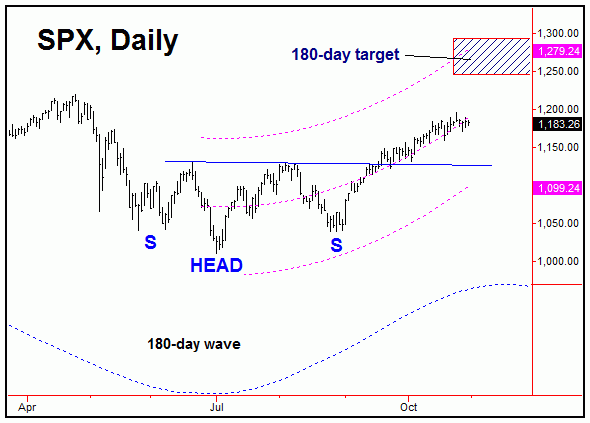
Of another technical mention is the inverted 'head & shoulder' pattern that the index took out to the upside, with the neckline of this pattern coming in at the 1129-1131 range - an area that won't likely be taken out again to the downside again - at least until this larger (180-day cycle) uptrend is complete.
With a larger 'C' wave rally then deemed to be in force with the 180 and 360-day cycles, there are some additional assumptions that can be made. That is, we know that this wave should end up as a 5-wave affair. And, inside that, we should view the 8/9/10 high of 1129.24 as wave '1', with the 8/27/10 low of 1039.70 as wave '2'. Obviously that would put the index in the middle of a wave '3' to the upside. Knowing the rule that wave 4 can't overlap wave 1, we know that the 1129.24 figure should not be seen again at any point during the remainder of the 180-day rally.
Going a bit further with the above, we need to take a look at the larger 360-day component - which is the cycle that will eventually top the even-larger four-year wave. This cycle is seen as 84 days along (off the July low) and is currently regarded as bullish. The upward phase of this wave should last into the April-July timeframe of 2011, then to set up a top with the four-year component. Here is a stepped-back view of this particular wave:
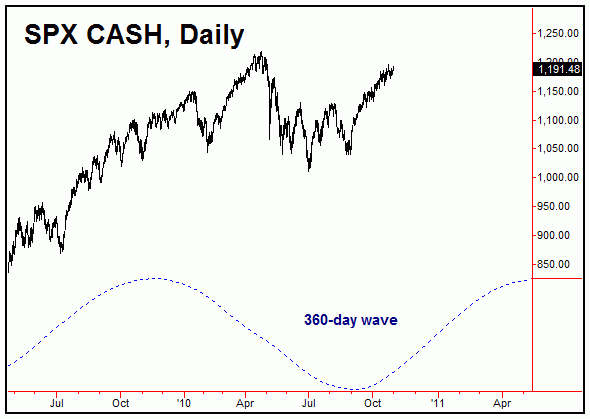
In taking a statistical look at this 360-day component, the average rally phase - when coming off the pattern of a 'higher-low' - has been in the range of 30% or better off the bottom. If seen here, then the inference would be for the SPX to test the 1300's or greater before this cycle's next peak is in place.
Having said and noted the above, if the 360-day cycle is able to register the pattern of a 'higher-low'/'higher-high' on it's current upward phase (as it should do here), then the average rally in the past has actually been closer to 40% off the bottom. In other words, if the latter is seen on the current rotation, it would put the SPX up to the low-1400's or better before the next 360-day top attempts to form. Right now, there is a current upside target with the 360-day cycle to the 1257.67 - 1312.51 area, which has good-odds of being upgraded at some point in the near-future. Here is a close-up view of this cycle, along with the noted price target:
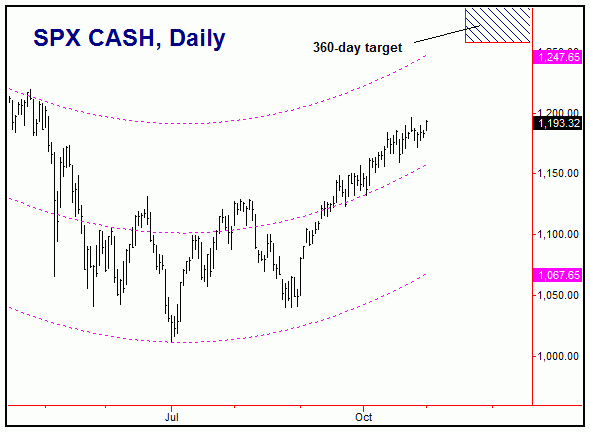
In terms of time, the greater-majority of the 360-day cycle upward phases in the past (i.e., within the current pattern) have lasted 194 trading days or more before topping, which - if seen on the current rotation - would tend to favor holding up into April, 2011 or later. However, Going a bit further, if the cycle is able to form the pattern of a 'higher-high' on it's current upward phase (which everything points to), then the average rallies have been in the range of 270 trading days before topping. In other words, if the latter is seen, then it could infer that this 360-day upward phase is going to last into July, 2011 or beyond.
The 4 Year Cycle
In taking a look inside the larger four-year cycle (noted earlier), this component is seen as 417 days along from the 03/06/09 low of 666.79 on the SPX and is currently regarded as bullish into at least February of 2011 or later; however, based upon the information from the smaller 360-day component, it should ideally remain in a bullish configuration through April, 2011 or beyond. The next bottom for this component is ideally due in the Autumn of 2012.
In terms of price, the average rally with this four-year cycle upward phase - when coming off the pattern of a 'lower-low' (which it registered at the March, 2009 bottom) - has been well over 100% from trough-to-peak. With that, the suggestion from my longer-term outlooks has been that the SPX would see an eventual push up to the 1330's or higher on or sometime before this cycle topped; this is now perfectly in line with the rally-statistics from the smaller 360-day wave, noted earlier. As a side note this four-year cycle has good-odds of confirming a new cyclic upside target to as high as the 1430-1550 level on the SPX CASH at some point in the near-future (though the target has yet to be confirmed at this time).
To sum up the mid-term picture on the SPX, the overall outlook favors higher highs into at least January of 2011, with the 1243.16 - 1286.36 level acting as a magnet. From a high in January (which should complete 5-waves up), the index would be set for a 3-wave correction into February or March, one which would bottom the 180-day cycle. From there, a renewed push to new highs would again be favored into April, 2011 - with the 360-day cycle looking for a potential test of the 1300's (plus or minus) on or before it tops.
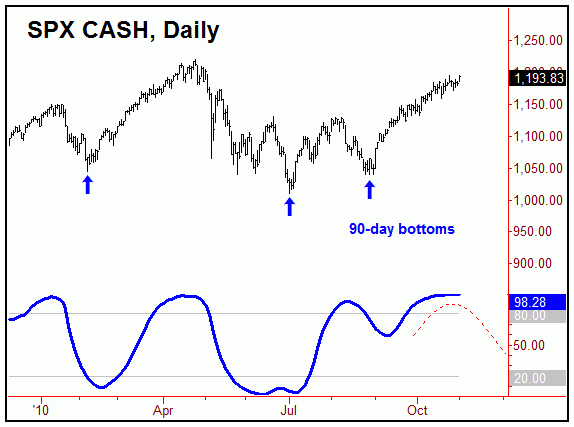
Shorter-Term
For the short-term view, the 90-day (18-week) cycle (chart, above) is currently pointing higher off of the late-August bottom, which puts it at 44 days along - and currently regarded as bullish. This cycle is ideally headed higher into around mid-November (plus or minus), with some test of the April high of 1219.80 ideally materializing at some point before it actually rolls over. Major near-term resistance for the upward phase of this component is at or near the 1230 figure (plus or minus) for the SPX, which is the 1.618 projection of the swing up from the July bottom to the early-August high. There is also a smaller 45-day (10-week) cycle, which either bottomed at the 1159.71 swing low (seen on 10/19/10) or, more likely, is extending it's peak - and thus will peak with the larger 90-day component sometime around mid-month.
Once the 90-day wave actually tops in the days/weeks ahead, the SPX should see it's largest percentage decline since coming off the 8/27/10 bottom of 1039.70. The way that path could play out in would be a high around the 1220-1230 level (plus or minus) with this cycle, then to be followed by a decline back to the 1150-1160 range on it's following downward phase. Since we have yet to see any meaningful retracement since coming off the August bottom, the assumption is that whatever decline that is seen with this wave will be an Elliott wave 4, which should come in the form of a 3-wave affair. This cycle is technically due to bottom in the late-November or early-to-mid December timeframe, and, once complete, should give way to new highs again into January, 2011 (i.e., wave 5), with the 180-day target to 1243.16 - 1286.36 acting as a magnet.
The 'Presidential Cycle'
Originally noted several times earlier this year, the current year 2010 had put the various indexes in 'mid-term' election year with the 'Presidential cycle' pattern, a year which has a history of recording major price bottoms. Normally, the mid-term/pattern will see strength in the earlier part of the year - which is then followed by a sharp decline into the Autumn months. From there, the market normally records a major low and then turns up into year-end and pushes higher well into the following year. What we saw on this go-around was a high in April (on time) - then an early bottom (made in July). With that, the U.S. stock indexes should be headed up into 2011, though, of course, with various corrections in-between.
There have been numerous studies regarding the presidential-cycle, but the biggest one of note is this: since the 1930's, the market has normally witnessed an average rally of around 50% from the mid-term bottom to the following year's (pre-election) high. Thus, if we take the July low of 1010.91 on the SPX and infer something similar on the current go-round, the index could be testing the 1500's again before all is said and done next year. Whether we will see this normal statistical rally is speculation and remains to be seen; however, with the four-year time cycle looking like it will confirm a projection into about the same vicinity, it is certainly viable here - especially in light of the time/cycle projections, which have a historical accuracy of better than 85%.
Taking all of the above together, the inference for the near-future is for a test of the April highs (plus or minus), then to set up a correction with the 90-day cycle - likely an Elliott wave 4. If seen in the weeks ahead, then we should look for higher highs to continue to materialize into January, 2011 or beyond, then to reasess the picture at the time to try and discern whether a 180-day top is being made. More on all of the above in a future article.
By Jim Curry
Market Turns Advisory
email: jcurry@cycle-wave.com
website: http://cyclewave.homestead.com
Jim Curry is the editor and publisher of Market Turns advisory, which specializes in using cyclical analysis to time the markets. To be added to our mailing list click HERE
Disclaimer - The financial markets are risky. Investing is risky. Past performance does not guarantee future performance. The foregoing has been prepared solely
for informational purposes and is not a solicitation, or an offer to buy or sell any security. Opinions are based on historical research and data believed reliable,
but there is no guarantee that future results will be profitable. The methods used to form opinions are highly probable and as you follow them for some time you
can gain confidence in them. The market can and will do the unexpected, use the sell stops provided to assist in risk avoidance. Not responsible for errors or
omissions. Copyright 1998-2010, Jim Curry
JIm Curry Archive
|
© 2005-2022 http://www.MarketOracle.co.uk - The Market Oracle is a FREE Daily Financial Markets Analysis & Forecasting online publication.



